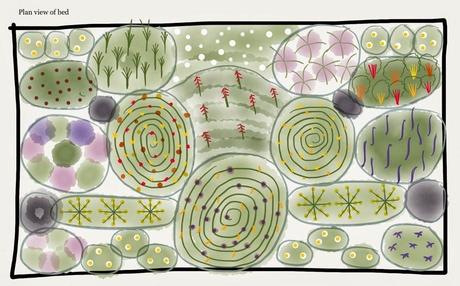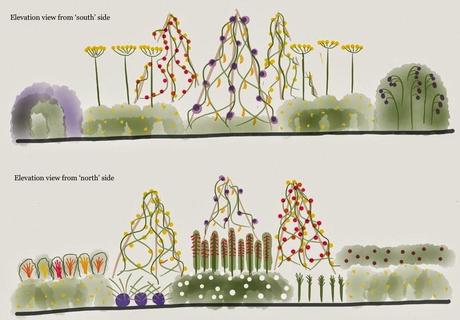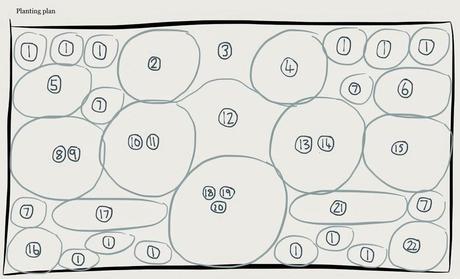The plans below are taken from my submitted application to the RHS. As Edible Patches is considered an amateur category, they weren't too prescriptive about how the submission was made. Which is lucky, as my autocad drawing skills are somewhat limited. So, drawing on my knowledge of garden design plan types, I went for a 'plan view' (a bird's eye view) of what the bed would look like and two 'elevation views' – a simple sketch giving a sense of what it would like standing at each of the long sides looking across the bed. My freehand drawing skills stopped developing at age 13, so I relied on my trusty iPad and an app called Paper to put my ideas down in a visually attractive way.The plan view gives a very simplistic impression, mainly concerned with color and texture variations between my selected crops and flowers. The plan is not to scale, so I also generalised the space taken up by each plant.

In the elevation views, you can get more of a feel to the vertical structure and hierarchy of the components of the raised bed. The 3 central circles in the plan view have become wigwams up which climbers will grow. Some plants are in symmetry across a central axis, some contrast with the plant adjacent or reflect some element of the plant at the opposite side.

Lastly, this is the planting plan and plant list. Still, the space taken by each type of plant is generalised but this allows you to see what plants I am intending to use in what area of the bed.

- Limnanthes douglasii (poached egg plant)
- Broccoli Kailan 'Kichi'
- Nasturtium 'Milkmaid'
- Kohl Rabi 'F1 Ballot'
- Asparagus pea
- Chard 'Bright Lights'
- Basil 'Red Rubin'
- Lettuce 'Romana Mortarella Verde D'Inverno'
- Lettuce 'Navara'
- Cucumber 'La Diva'
- Climbing Nasturtium mixed
- Broad Beans 'Crimson Flowered'
- Lathyrus chloranthus 'Lemonade' (sweet pea)
- Cucamelon
- Purple dwarf french beans
- Sage
- Dill 'Bouquet'
- Pea 'Golden Sweet'
- Lancashire Lad purple podded pea
- Lathyrus odoratus 'Matucana' (sweet pea)
- Fennel
- Cerinthe major 'purpurescens'
My selection criteria for these were:
* edible crop or companion plant with a specific benefit to edible crops
* can be grown from seed
* easy to grow – no specialist gardening knowledge or equipment needed
* has an attractive merit: flower colour/shape, colourful leaves/stems, unusual variety, productive crop
The Edible Patches are designed to show how a small area can be turned over to edible crops, so I made sure that everything I chose will how well in shallow soil or containers (as some people's small space might be a patio or balcony and I wanted to show how quickly edibles can get from sowing to harvest.I may have to make a few small tweaks/changes to this design by the time the show comes around. My sage is an existing plant in a beautiful container, that was grown from seed a few years ago. I have plenty of back-up plants as well as a few replacements in case one variety fails, succumbs to pests or simply gives up the ghost in the next few weeks. But I hope to stick as faithfully to my original design as I can.
